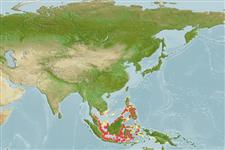Teleostei (teleosts) >
Blenniiformes (Blennies) >
Blenniidae (Combtooth blennies) > Blenniinae
Etymology: Enchelyurus: Greek, enchelys, = eel + Greek, oura = tail (Ref. 45335).
More on author: Peters.
Environment: milieu / climate zone / depth range / distribution range
Ecology
Marine; demersal. Tropical
Western Pacific: South China Sea.
Size / Weight / Age
Maturity: Lm ? range ? - ? cm
Max length : 7.6 cm TL male/unsexed; (Ref. 90102)
Short description
Identification keys | Morphology | Morphometrics
Dorsal spines (total): 7 - 8; Dorsal soft rays (total): 24 - 27; Anal spines: 2; Anal soft rays: 18 - 23. Dark brown to blackish with anal, caudal and posterior half of dorsal fins yellow. \female urogenital region conspicuously pigmented, much darker than surrounding area. Dorsal rays usually VII,25-26; pectoral rays usually 16; pelvic spine hidden; segmented caudal rays 14, all unbranched; lateral-line tubes 4-8; teeth incisiform, fewer than 50 in each jaw with large canine on side of both upper and lower jaw; head cirri absent; dorsal and anal fin bound to caudal fin by membrane, body depth about 4.1-4.4 in SL (Ref. 90102).
Adults inhabit shallow coral reefs, probably (Ref. 90102). Oviparous. Eggs are demersal and adhesive (Ref. 205), and are attached to the substrate via a filamentous, adhesive pad or pedestal (Ref. 94114). Larvae are planktonic, often found in shallow, coastal waters (Ref. 94114).
Life cycle and mating behavior
Maturity | Reproduction | Spawning | Eggs | Fecundity | Larvae
Oviparous, distinct pairing (Ref. 205).
Randall, J.E. and K.K.P. Lim (eds.), 2000. A checklist of the fishes of the South China Sea. Raffles Bull. Zool. Suppl. (8):569-667. (Ref. 36648)
IUCN Red List Status (Ref. 130435: Version 2024-2)
Threat to humans
Harmless
Human uses
Tools
Special reports
Download XML
Internet sources
Estimates based on models
Preferred temperature (Ref.
123201): 28.4 - 29.3, mean 28.9 °C (based on 1288 cells).
Phylogenetic diversity index (Ref.
82804): PD
50 = 0.5312 [Uniqueness, from 0.5 = low to 2.0 = high].
Bayesian length-weight: a=0.00575 (0.00253 - 0.01308), b=3.06 (2.86 - 3.26), in cm total length, based on LWR estimates for this (Sub)family-body shape (Ref.
93245).
Trophic level (Ref.
69278): 3.4 ±0.4 se; based on size and trophs of closest relatives
Resilience (Ref.
120179): High, minimum population doubling time less than 15 months (Preliminary K or Fecundity.).
Fishing Vulnerability (Ref.
59153): Low vulnerability (10 of 100).
